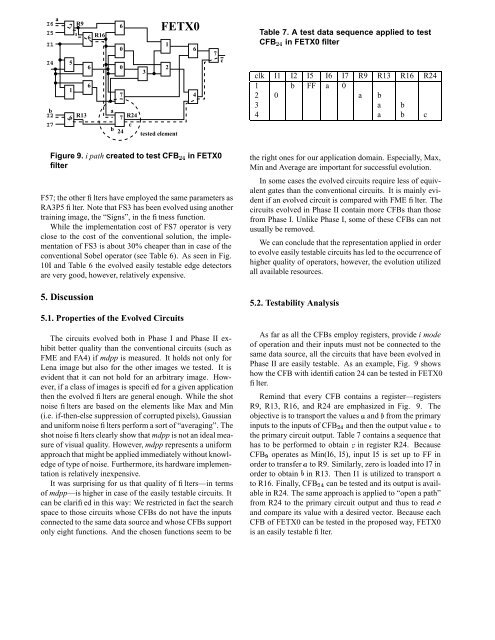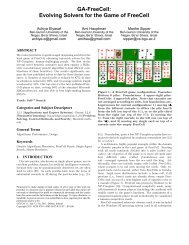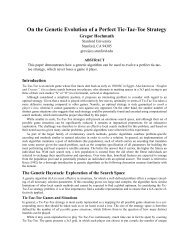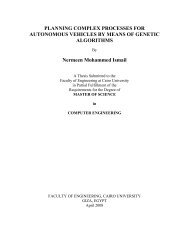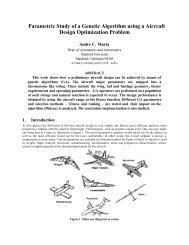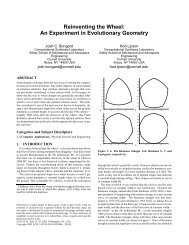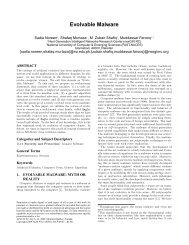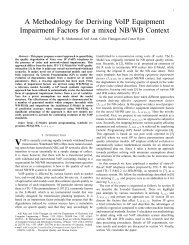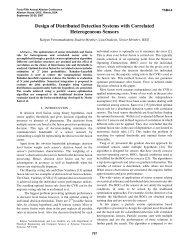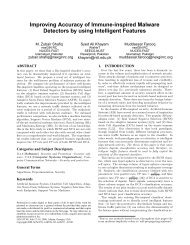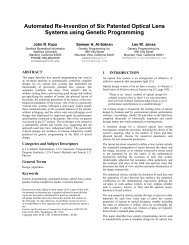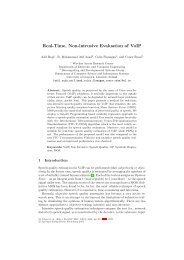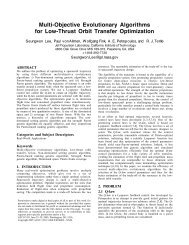Novel image filters implemented in hardware - Genetic ...
Novel image filters implemented in hardware - Genetic ...
Novel image filters implemented in hardware - Genetic ...
Create successful ePaper yourself
Turn your PDF publications into a flip-book with our unique Google optimized e-Paper software.
a<br />
I6<br />
I5<br />
I1<br />
I4<br />
b<br />
I2<br />
I7<br />
7 R9<br />
6<br />
5<br />
6<br />
6<br />
1<br />
6 R13<br />
R16<br />
a<br />
b<br />
6<br />
0<br />
1<br />
0<br />
3<br />
2<br />
7<br />
7 R24<br />
c<br />
24 tested element<br />
FETX0<br />
6<br />
4<br />
7<br />
c<br />
Table 7. A test data sequence applied to test<br />
<strong>in</strong> FETX0 filter<br />
CFB¡<br />
clk I1 I2 I5 I6 I7 R9 R13 R16 R24<br />
1 b FF a 0<br />
2 0 a b<br />
3 a b<br />
4 a b c<br />
Figure 9. i path created to CFB¡<br />
test<br />
filter<br />
<strong>in</strong> FETX0<br />
F57; the other <strong>filters</strong> have employed the same parameters as<br />
RA3P5 filter. Note that FS3 has been evolved us<strong>in</strong>g another<br />
tra<strong>in</strong><strong>in</strong>g <strong>image</strong>, the “Signs”, <strong>in</strong> the fitness function.<br />
While the implementation cost of FS7 operator is very<br />
close to the cost of the conventional solution, the implementation<br />
of FS3 is about 30% cheaper than <strong>in</strong> case of the<br />
conventional Sobel operator (see Table 6). As seen <strong>in</strong> Fig.<br />
10I and Table 6 the evolved easily testable edge detectors<br />
are very good, however, relatively expensive.<br />
5. Discussion<br />
5.1. Properties of the Evolved Circuits<br />
The circuits evolved both <strong>in</strong> Phase I and Phase II exhibit<br />
better quality than the conventional circuits (such as<br />
FME and FA4) if mdpp is measured. It holds not only for<br />
Lena <strong>image</strong> but also for the other <strong>image</strong>s we tested. It is<br />
evident that it can not hold for an arbitrary <strong>image</strong>. However,<br />
if a class of <strong>image</strong>s is specified for a given application<br />
then the evolved <strong>filters</strong> are general enough. While the shot<br />
noise <strong>filters</strong> are based on the elements like Max and M<strong>in</strong><br />
(i.e. if-then-else suppression of corrupted pixels), Gaussian<br />
and uniform noise <strong>filters</strong> perform a sort of “averag<strong>in</strong>g”. The<br />
shot noise <strong>filters</strong> clearly show that mdpp is not an ideal measure<br />
of visual quality. However, mdpp represents a uniform<br />
approach that might be applied immediately without knowledge<br />
of type of noise. Furthermore, its <strong>hardware</strong> implementation<br />
is relatively <strong>in</strong>expensive.<br />
It was surpris<strong>in</strong>g for us that quality of <strong>filters</strong>—<strong>in</strong> terms<br />
of mdpp—is higher <strong>in</strong> case of the easily testable circuits. It<br />
can be clarified <strong>in</strong> this way: We restricted <strong>in</strong> fact the search<br />
space to those circuits whose CFBs do not have the <strong>in</strong>puts<br />
connected to the same data source and whose CFBs support<br />
only eight functions. And the chosen functions seem to be<br />
the right ones for our application doma<strong>in</strong>. Especially, Max,<br />
M<strong>in</strong> and Average are important for successful evolution.<br />
In some cases the evolved circuits require less of equivalent<br />
gates than the conventional circuits. It is ma<strong>in</strong>ly evident<br />
if an evolved circuit is compared with FME filter. The<br />
circuits evolved <strong>in</strong> Phase II conta<strong>in</strong> more CFBs than those<br />
from Phase I. Unlike Phase I, some of these CFBs can not<br />
usually be removed.<br />
We can conclude that the representation applied <strong>in</strong> order<br />
to evolve easily testable circuits has led to the occurrence of<br />
higher quality of operators, however, the evolution utilized<br />
all available resources.<br />
5.2. Testability Analysis<br />
As far as all the CFBs employ registers, provide i mode<br />
of operation and their <strong>in</strong>puts must not be connected to the<br />
same data source, all the circuits that have been evolved <strong>in</strong><br />
Phase II are easily testable. As an example, Fig. 9 shows<br />
how the CFB with identification 24 can be tested <strong>in</strong> FETX0<br />
filter.<br />
Rem<strong>in</strong>d that every CFB conta<strong>in</strong>s a register—registers<br />
R9, R13, R16, and R24 are emphasized <strong>in</strong> Fig. 9. The<br />
objective is to transport the # and! values from the primary<br />
<strong>in</strong>puts to the <strong>in</strong>puts CFB¡<br />
of and then the output ¢ value to<br />
the primary circuit output. Table 7 conta<strong>in</strong>s a sequence that<br />
has to be performed to ¢ obta<strong>in</strong> <strong>in</strong> register R24. Because<br />
operates as M<strong>in</strong>(I6, I5), <strong>in</strong>put I5 is set up to FF <strong>in</strong><br />
CFB£<br />
order to # transfer to R9. Similarly, zero is loaded <strong>in</strong>to I7 <strong>in</strong><br />
order obta<strong>in</strong>! to <strong>in</strong> R13. Then I1 is utilized to # transport<br />
to R16. CFB¤<br />
F<strong>in</strong>ally, can be tested and its output is available<br />
<strong>in</strong> R24. The same approach is applied to “open a path”<br />
from R24 to the primary circuit output and thus to ¢ read<br />
and compare its value with a desired vector. Because each<br />
CFB of FETX0 can be tested <strong>in</strong> the proposed way, FETX0<br />
is an easily testable filter.


